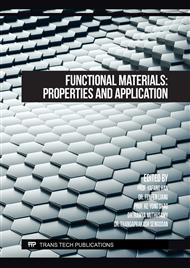[1]
HE Jia-hua, GUO xi-ping, QIAO Yan-qiang. Oxidation and hot corrosion behaviors of Nb-Si based ultrahigh temperature alloys at 900℃[J]. Transactions of Nonferrous Metals Society of China, 2021, 31: 207-210.
DOI: 10.1016/s1003-6326(20)65488-7
Google Scholar
[2]
MENG Jun-sheng, CHEN Ming-xuan, SHI Xiao-ping, et al. Transactions of Nonferrous Metals Society of China [J]. 2021,31: 2402-2414.
Google Scholar
[3]
WU Yu-xiao, ZHANG Heng, LI Fu-lin, et al. Kinetics and microstructural evolution during recrystallization of a Ni3Al-based single crystal superalloy [J]. Transactions of Nonferrous Metals Society of China, 2012, 22: 2098-2105.
DOI: 10.1016/s1003-6326(11)61434-9
Google Scholar
[4]
ZHOU Peng-jie, YU Jin-jiang, SUN Xiao-feng, et al. Roles of Zr and Y in cast microstructure of M951 nickel-based superalloy [J]. Transactions of Nonferrous Metals Society of China, 2012, 22: 1594-1598.
DOI: 10.1016/s1003-6326(11)61361-7
Google Scholar
[5]
MENG Jun-sheng, JI Ze-sheng. Effect of different fillers on oxidation behavior of low-temperature chromizing coating [J]. Transactions of Nonferrous Metals Society of China, 2014, 24: 1785-1790.
DOI: 10.1016/s1003-6326(14)63254-4
Google Scholar
[6]
STRINGER J. Hot corrosion of high-temperature alloys. Annual Revies of Materials Science 1977;7: 477-509.
Google Scholar
[7]
WOOD G C. Stott F H. Directions for future research in high-temperature corrosion. Oxid [J]. Met 1995;44(1/2): 375-397.
DOI: 10.1007/bf01046733
Google Scholar
[8]
PARK S J, SEO S M, YOO Y S, et al. Effects of Cr, W, and Mo on the high temperature oxidation of Ni-based superalloys [J]. Materials, 2019, 12: 2934.
DOI: 10.3390/ma12182934
Google Scholar
[9]
PEDRAZZINI S, CHILD D J, WEST G, et al. Oxidation behavior of a next generation polycrystalline Mn containing Ni-based superalloy [J]. Scripta Materialia, 2016, 113: 51-54.
DOI: 10.1016/j.scriptamat.2015.10.001
Google Scholar
[10]
CHOI S C, CHO H J, LEE D B. Effect of Cr, Co, and Ti additions on the high-temperature oxidation behavior of Ni3Al [J]. Oxidation of Metals, 1996, 46: 109-127.
DOI: 10.1007/bf01046886
Google Scholar
[11]
WEISER M, GALETZ M C, CHATER R J, et al. Growth mechanisms of oxide scales on two-phase Co/Ni-base model alloys between 800℃ and 900℃ [J]. Journal of The Electrochemical Society, 2020, 167: 021504.
DOI: 10.1149/1945-7111/ab69f7
Google Scholar
[12]
ISMAIL F B, VORONTSOV V A, LINDLEY T C. Alloying effects on oxidation mechanisms in polycrystalline Co–Ni base superalloys [J]. Corrosion Science, 2017, 116: 44-52.
DOI: 10.1016/j.corsci.2016.12.009
Google Scholar
[13]
QIAO Min, ZHOU Chun-gen. Hot corrosion behavior of Co modified NiAl coating on nickel base superalloys [J]. Corrosion Science, 2012, 63: 239-245.
DOI: 10.1016/j.corsci.2012.06.027
Google Scholar
[14]
FAN Q X, JIANG S M, WU D L, et al. Preparation and hot corrosion behaviour of two Co modified NiAl coatings on a Ni-based superalloy [J]. Corrosion Science, 2013, 76: 373-381.
DOI: 10.1016/j.corsci.2013.07.008
Google Scholar
[15]
Gonzalez-Rodriguez J G, Haro S, Martinez-Villafane A. Porcayo-Calderon J. Corrosion performance of heat resistant alloys in Na2SO4-V2O5 molten salts. Mater Sci Eng A 2006, 435: 258-265.
DOI: 10.1016/j.msea.2006.06.138
Google Scholar
[16]
Uusitalo MA, Vuoristo PMJ, Maantyla TA. High temperature corrosion of coatings and boiler steels below chlorine-containing salt deposits. Corros Sci 2004, 46:1311-1331.
DOI: 10.1016/j.corsci.2003.09.026
Google Scholar
[17]
Li J, Wang H M. Microstructure and mechanical properties of rapid directionally solidified Ni-base superalloy Rene41 by laser melting deposition manufacturing. Mater Sci Eng A 2010, 527:4823-4829.
DOI: 10.1016/j.msea.2010.04.062
Google Scholar
[18]
Liu L, Li Y, Wang F H. Influence of micro-structure on corrosion behavior of a Ni-based superalloy in 3.5% NaCl. Electrochim Acta 2007, 52:7193-7202.
DOI: 10.1016/j.electacta.2007.05.043
Google Scholar
[19]
HUANG Shuo, W ANG Lei, HUANG Yan, LI Jun-tao. High temperature hot corrosion behaviors of directional solidification Ni-base superalloy DZ792 and DZ792G[J]. Journal of Northeastern University, 2013, 34(11): 1580−1584.
Google Scholar
[20]
GOWARD G. Protective coatings-purpose, role, and design [J]. Material Science Engineering, 1986, 2: 194-200.
Google Scholar
[21]
NIU Y, ZHANG X J, WU Y, GESMUNDO F. The third-element effect in the oxidation of Ni-xCr-7Al (x = 0, 5, 10, 15 at. %) alloys in 1 atm O2 at 900-1000℃[J]. Corrosion Science, 2006, 48: 4020-4036.
DOI: 10.1016/j.corsci.2006.03.008
Google Scholar
[22]
J. Engkvist, U. Bexell, M. Grehk, et al, High temperature oxidation of FeCrAl-alloys - Influence of Al-concentration on oxide layer characteristics [J]. Mater. Corros 2009, 60: 876-881.
DOI: 10.1002/maco.200805186
Google Scholar


